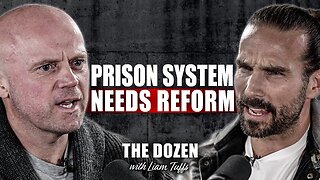Premium Only Content

Thankful there is Gold | The Gold Standard 2346
https://www.midasgoldgroup.com/
Join our insightful hostess, Jennifer Horn, in a compelling conversation with special guest Ken Russo. This episode explores economic uncertainties and the crucial role that gold plays in preserving wealth. As we navigate through today’s turbulent financial landscape, Ken unravels the impact of the US fiat currency and the fractional reserve banking system on the corrosive devaluation of our dollars. Discover why being thankful for gold is not just a sentiment but a strategic choice in safeguarding the future of your finances.
Unseen Forces Behind Historic Decisions
Despite its outward image of authority, the presidency often reveals a complex interplay of influences where decisions extend beyond the individual in the Oval Office. President Richard Nixon’s pivotal move in 1971 to sever the ties between the US dollar and the gold standard is a poignant illustration of this phenomenon. Though history marks this event as a presidential decision, it illuminates the intricate web of factors shaping executive actions. Behind closed doors, economic advisers, geopolitical strategists, and financial architects were instrumental in shaping this historic shift. The decision to unpeg the US dollar from gold reflects the intricate dance between economic forces and political decision-making.
“Worried about your deposits? Or the bank shares in your portfolio? You should be. Trouble lies ahead.”
—Charles Calomiris,
Economist and Professor, New University of Austin
The Pitfalls of Fiat Currency
Using paper money (fiat currency) and relying on a central banking system can be risky. A significant government deficit makes it hard for the Federal Reserve to control rising prices. To cope, the government might start relying on an “inflation tax” by making money and bank deposits worth less over time, causing people to move their money out of banks to avoid losing value. If too many customers withdraw their money simultaneously, big banks could have problems, as we’ve seen happen several times recently. High inflation makes regular savings methods less reliable. It’s a reminder that our money system isn’t foolproof, and we should consider how it affects our savings and the overall economy.
Searching for Stability
In the 2020s, the decades-long bond bull market stopped, bringing about a fourfold increase in yields on long-dated government bonds. Amid this financial shift, the spotlight falls on James Grant, a seasoned analyst and publisher of Grant’s Interest Rate Observer, who stands firm in his bearish perspective on government bonds and the underlying dollars. Grant’s skepticism extends to the Federal Reserve’s approach to monetary management, and he advocates for gold as a more dependable store of value. Citing historical examples and critiquing profligate political tendencies, Grant warns of the potential consequences of an 8% inflation tax on currency and bank deposits. Investors must exercise caution in the face of rising interest rates by diversifying with gold and silver in fixed-income portfolios.
Moody’s Red Flags for the US Economy
Moody’s recent shift in the Outlook for the US Sovereign Credit Rating from Neutral to Negative has sent ripples through the financial landscape, signaling potential challenges for the country’s creditworthiness. This move, coming on the heels of a similar downgrade by Fitch Ratings, suggests a growing concern about the fiscal strength of the United States. Moody’s, one of the leading credit rating agencies, attributes the negative outlook to unchecked government spending and a mounting debt burden, echoing sentiments expressed by other agencies. The ongoing political polarization in Congress, marked by repeated debt ceiling showdowns and government shutdown threats, contributes to the assessment that the government faces dysfunction. Moody’s pessimism extends to the near-term prospects of Congress taking adequate measures to address the declining fiscal strength, pointing to the political calendar and suggesting that significant policy responses may not materialize until 2025. With the potential loss of the last remaining top-tier credit rating looming, the impact of Moody’s warning underscores the urgency for policymakers to address the country’s fiscal challenges.
The Silver Morgan Dollar
The Morgan Dollar holds significant importance for the average saver and investor as a tangible piece of American history with intrinsic and numismatic value. Minted from 1878 to 1904 and again in 1921, these silver dollars are a testament to the nation’s economic evolution and serve as a tangible representation of wealth preservation. For the average saver, acquiring Morgan Dollars provides a unique opportunity to hold a physical asset that has stood the test of time, offering a sense of stability and connection to the past. The silver content and the potential appreciation in numismatic value over time make the Morgan Dollar series attractive to investors. As part of the coin-collecting community, Morgan Dollars hold a special place, symbolizing a bygone era of American coinage while offering historical and monetary value to those seeking a diversified and tangible investment. Indeed, Morgan Dollars remain the most collected US coins of all time.
____________________________________________________________________________________________________
Listen to The Gold Standard: https://www.midasgoldgroup.com/gold-standard-radio-show/
Gold IRA: https://www.midasgoldgroup.com/gold-ira/
Invest in Gold: https://www.midasgoldgroup.com/buy-gold/
Guide to Owning Bullion & Coins: https://www.midasgoldgroup.com/bullion-guide/
Read the latest precious metals news: https://www.midasgoldgroup.com/news/
-
 25:03
25:03
Midas Gold Group
5 months agoPrepare Yourself for an October 22 Surprise | The Gold Standard 2433
40 -
 LIVE
LIVE
Nerdrotic
2 hours agoDown the Rabbit Hole with Kurt Metzger | Forbidden Frontier #090
2,439 watching -
 LIVE
LIVE
vivafrei
8 hours agoEp. 251: Bogus Social Security Payments? DOGE Lawsduit W's! Maddow Defamation! & MORE! Viva & Barnes
23,504 watching -
 LIVE
LIVE
Vigilant News Network
6 hours agoBombshell Study Reveals Where the COVID Vaccine Deaths Are Hiding | Media Blackout
2,400 watching -
 LIVE
LIVE
Sarah Westall
2 hours agoDOGE: Crime & Hysteria bringing the Critics & the Fearful - Plus new CDC/Ukraine Crime w/ Dr Fleming
532 watching -
 45:39
45:39
Survive History
7 hours agoCould You Survive in the Shield Wall at the Battle of Hastings?
1151 -
 1:50:28
1:50:28
TheDozenPodcast
6 hours agoViolence, Abuse, Jail, Reform: Michael Maisey
2.24K -
 23:01
23:01
Mrgunsngear
1 day ago $1.18 earnedWolfpack Armory AW15 MK5 AR-15 Review 🇺🇸
5.26K11 -
 25:59
25:59
TampaAerialMedia
1 day agoUpdate ANNA MARIA ISLAND 2025
3.41K1 -
 59:31
59:31
Squaring The Circle, A Randall Carlson Podcast
8 hours ago#039: How Politics & War, Art & Science Shape Our World; A Cultural Commentary From Randall Carlson
3.39K2